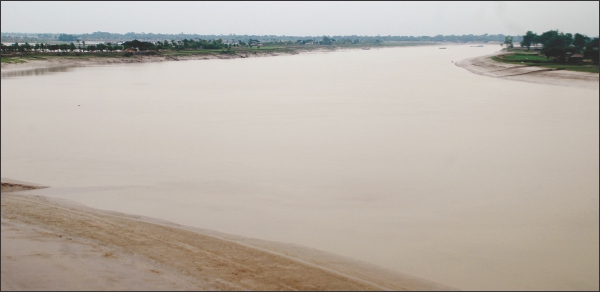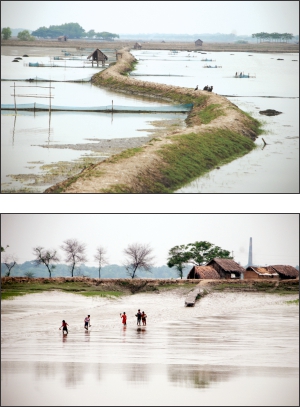Farmers’s Voice

The Dying Waterway
The river is filled with sediments – 1.5 million people living in fifteen upazilas of five southern districts are living a life that is called, 'inhuman'. Most of the areas here are now waterlogged. This has shaped for the last twelve years. The way lifestyles changed here for the people, the way water-logging shattered their hopes and made them ultra-poor, the way their fundamental rights collapsed, you will today learn how difficult their realities are.
.................................................................................................
Shykh Seraj
Kopotakkho river is narrated by the great poet Michael Madhusudan Dutta. He rightly narrated of its beauty and of the abundant flow of the river, a river that entwines lives of millions of people of the southern region of Bangladesh. Since the ancient time, the river has been a blessing for the region. However, it is now all memory and all but frustration. All the great stories of Kopotakkho have now become past. This huge river has now turned into a canal. Kopotakkho is now almost a dead river.
 I went to Khulna and Jessore and specifically to Tala upazila in Satkhira and saw these dreadful scenes. Boats can't go to the other side of the river because of the silts. At best, three-hand water is there in the river. The navigability of Kopotakkho decreased so severely that an adult can easily walk through the river. On my request, an adult man walked through the river in front my own eyes! It was a shocking image! However, overflowing water is seen right after the monsoon. I went to Khulna and Jessore and specifically to Tala upazila in Satkhira and saw these dreadful scenes. Boats can't go to the other side of the river because of the silts. At best, three-hand water is there in the river. The navigability of Kopotakkho decreased so severely that an adult can easily walk through the river. On my request, an adult man walked through the river in front my own eyes! It was a shocking image! However, overflowing water is seen right after the monsoon.
Kopotakkho is dying – a threat for sure. The nature is becoming rigid. During the monsoon, water-logging and during the dry season, 'waterless' is the state, millions have to suffer here. I talked with some local farmers and they are frustrated like anything.
“We can't cultivate paddies. We don't have any jobs in the region. We are dying here.”
“For how long, this is happening?”
“It's been twelve years now.”
They can't produce anything. So how are they living and leading their life. I wanted to know about the solution and the reply was pretty normal and realistic.
“The main solution is to solve the river crisis.”
“When the river was flowing without interruption, we could barely notice any problem. It was simply a great time in the past”, added the locals.
Due to salinity, grown up by water-logging, farmers have left cultivating crops. Everything is doomed under saline water. Specially, during the last twelve years, the two river sides of the river have turned like what has happened in 'Bhobodaho', another water-logged region of Bangladesh. Now the people of the region bear two heavy sufferings- the tragic death of Kopotakkho and the curse called, 'water-logging'.
Meanwhile, I came across a very old man, Chand Ali Gazi, 105-years old in Agorkata. I was curious to learn from his eyes how he saw the Kopotakkho.
“Were you born here?”
“Yes.”
“Please tell me how have you seen the Kopotakkho in the past?”
“This is not the real Kopotakkho. It was full of life, full and plenty of water.”
Regarding the humiliating state of Kopotakkho and the severe strike of cyclone Aila and of course regarding the water-logging, I talked with a conscious farmer of the region, G.M. Nurul Islam.
 “The saline water is destroying the plants and biodiversity of the region. Aila dealt with devastating blows here. Cultivation system has collapsed and we barely see seasonal paddy cultivation here.” “The saline water is destroying the plants and biodiversity of the region. Aila dealt with devastating blows here. Cultivation system has collapsed and we barely see seasonal paddy cultivation here.”
Kopotakkho has lost its capacity of carrying water. With the start of monsoon, Khulna's Paikgacha, Satkhira's Tala Sadar, and villages beside Kopotakkho in Kolaroa, Jessore's Monirampur and Keshabpur upazila go under water. Millions of people become waterlogged. Thousands of acres of land remain uncultivated. People, living by the banks of Kopotakkho don't even know whether their despair will ever end or not.
“The sediment is being piled in Kopotakkho. By the next monsoon, the river will be sealed with silts. It will definitely be by the next monsoon. If we can do something about the river navigability, only then the region will saved”, added G.M. Nurul Islam.
Why such suffering has occurred? Why Bangladesh is losing its rivers and water ways? Why, one after the other, regions are becoming waterlogged? The locals believe during the 60s when the world was forced to produce more, the then East-Pakistan regime constructed embankments and sluice gates with the help of Water Development Board in a completely unplanned method. It created great obstacles in the regular river flow. In addition, illegal occupants started occupying the river areas which slowly pushed the river into the mouth of death. Those who are revolting for long for the revival of the river, they believe it all started during the British regime, when in Darshana, Keru & Co. was established. I talked with the Chief Advisor of Save Kopotakkho Movement, Iqbal Kabir Jahid.
“During the establishment of Darshana Sugar Mill in 1938, the connection between Mathabhanga and Bhairav river was permanently sealed. Since then, Kopotakkho and Chitra rivers started dying”, said Iqbal.
“Some say that Farakka barrage has created this problem. Yes, Farakka is a big problem for Bangladesh, but not for this region. If the connection could be reestablished between Mathabhanga and Bhairav, problems could have been solved”, added Iqbal.
Kopotakkho is a branch river of Bhairav. The community before the 'Dravid's used to call the river, 'Kobdaru'. At the south of Jhenaidah's Kotchandpur from the Bhairav river, a branch went towards south to meet Shibsha river, situated in Khulna's Paikgacha. In reality, Kopotakkho has taken birth from Mathabhanga river. Mathabhanga had a turn right where Kopotakkho was born. To cut back the distance, a canal was dredged and the river flow of Mathabhanga was redirected which ultimately brought an end to the connection between Mathabhanga and Kopotakkho. Since then, Kopotakkho got connected with Bhairav. As connections were lost from Ganges to Mathabhanga and then from Mathabhanga to Kopotakkho, the river flows became so narrow. Apart from regular monsoon, the river depends on irregular rainfalls and water coming from other rivers, as the predominant source of water. In most areas, the river lost its navigability.
Every year, there are allocations for dredging. But, the road where I was walking had been dredged to bring in the river flow. The dredging isn't done in a planned way. Locals say that dredging won't save the river and I also agree with them, looking at the realities.
As around 80 canals, were disconnected from the river, millions of fishers and fish-farming family are now suffering like anything. If you go to Mojhiara, Shivpur, Khanpur, Khersa, Baligram in Tala upazila, people have no end to their suffering.
Kanu who lives in Khanpur village, was returning home by the river side. The river navigability was at a poor state here as I noticed. I requested him to walk through the river which he did ever so simply.
How can we save Kopotakkho? Meanwhile, government has taken a 261 crore taka dredging project. Local farmers stand against such projects and add that such dredging will never save Kopotakkho.
“What's the solution then”, I asked local farmers.
“If at the Shibsha bridge, five or six sluice gates are built, only then water could be extracted from the region that would save millions of people”, replied one conscious farmer from the group.
I talked with Sub-Divisional Engineer of Bangladesh Water Development Board, Mr. Abdul Motaleb.
“The TRM (Tidal River Management) has started during FY 2011-2012. This year, government has taken some more river dredging in hand.”
“I noticed that people are walking through the river Kopotakkho. You can guess how much silt has been piled under water. Do you really believe that only dredging can save the people from water-logging and other crises?”
“We'll have to keep going with the TRM.”
“It's pretty difficult for a government to continue TRM, isn't it?”
“No, it's the easiest and low-cost effective way that government has.”
Thus said the Engineer and I smelt 'no solution'. On the contrary, Iqbal is completely against this government project.
“If government completes the 261 crore taka project by 100%, the problem won't be solved- we are clear with our message”, added the Chief Advisor, Iqbal on behalf of Save Kopotakkho Movement.
What is to be done? He has some well thought recommendations.
“We are requesting the government not to waste the money. Rather, under this project, we want Mathabhanga river to be reconnected with Kapotakkho. Perhaps, government will need to bear another 10 crore taka or some more investment than that. Only then, this 261 crore taka won't be wasted”, said Iqbal with utter confidence.
“Waters will flow through from Mathabhanga and at this part government can keep on working with the TRM”, added Iqbal.
Yes, that sounded realistic to me.
“We don't want extraction, we want river flow that will ultimately save the river”, said another local environmentalist.
Dear readers, due to the unplanned mistakes, the new projects are unable to work out. The situation is worsening as days are going by while we already lost river navigability in many places. There are many rivers which are now facing the same reality of Kopotakkho. Millions of people of the southern region are now living in a deathtrap.
Only if Kopotakkho is saved, they'll be saved. Or else, the situation will worsen. Food security and faring sector will face numerous challenges. All these issues should be considered seriously. With the effective plans, we have to ensure the life of Kopotakkho, agricultural sustainability, bio-diversity and the riverine culture of Bangladesh.
Otherwise, Michael Madhusudan's dream on Kopotakkho river will remain only as a dream without its actual existence.

Copyright
(R) thedailystar.net 2012 |


 I went to Khulna and Jessore and specifically to Tala upazila in Satkhira and saw these dreadful scenes. Boats can't go to the other side of the river because of the silts. At best, three-hand water is there in the river. The navigability of Kopotakkho decreased so severely that an adult can easily walk through the river. On my request, an adult man walked through the river in front my own eyes! It was a shocking image! However, overflowing water is seen right after the monsoon.
I went to Khulna and Jessore and specifically to Tala upazila in Satkhira and saw these dreadful scenes. Boats can't go to the other side of the river because of the silts. At best, three-hand water is there in the river. The navigability of Kopotakkho decreased so severely that an adult can easily walk through the river. On my request, an adult man walked through the river in front my own eyes! It was a shocking image! However, overflowing water is seen right after the monsoon.  “The saline water is destroying the plants and biodiversity of the region. Aila dealt with devastating blows here. Cultivation system has collapsed and we barely see seasonal paddy cultivation here.”
“The saline water is destroying the plants and biodiversity of the region. Aila dealt with devastating blows here. Cultivation system has collapsed and we barely see seasonal paddy cultivation here.” 